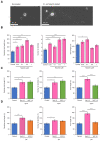A novel cyclic peptide (Naturido) modulates glia-neuron interactions in vitro and reverses ageing-related deficits in senescence-accelerated mice
- PMID: 33503058
- PMCID: PMC7840003
- DOI: 10.1371/journal.pone.0245235
A novel cyclic peptide (Naturido) modulates glia-neuron interactions in vitro and reverses ageing-related deficits in senescence-accelerated mice
Abstract
The use of agents that target both glia and neurons may represent a new strategy for the treatment of ageing disorders. Here, we confirmed the presence of the novel cyclic peptide Naturido that originates from a medicinal fungus (Isaria japonica) grown on domestic silkworm (Bombyx mori). We found that Naturido significantly enhanced astrocyte proliferation and activated the single copy gene encoding the neuropeptide VGF and the neuron-derived NGF gene. The addition of the peptide to the culture medium of primary hippocampal neurons increased dendrite length, dendrite number and axon length. Furthermore, the addition of the peptide to primary microglial cultures shifted CGA-activated microglia towards anti-inflammatory and neuroprotective phenotypes. These findings of in vitro glia-neuron interactions led us to evaluate the effects of oral administration of the peptide on brain function and hair ageing in senescence-accelerated mice (SAMP8). In vivo analyses revealed that spatial learning ability and hair quality were improved in Naturido-treated mice compared with untreated mice, to the same level observed in the normal ageing control (SAMR1). These data suggest that Naturido may be a promising glia-neuron modulator for the treatment of not only senescence, but also Alzheimer's disease and other neurodegenerative diseases.
Conflict of interest statement
The authors have read the journal’s policy and the authors of this manuscript have the following competing interests: KS, SI, MK, ME, PS, HI and NE are paid employees of DKS Co., Ltd. (the parent company of Biococoon Laboratories, Inc.). This does not alter our adherence to PLOS ONE policies on sharing data and materials. There are no products in development or marketing products to declare. Biococoon Laboratories, Inc. and Lotte Co., LTD. have patents and those pending that are related to this study: JP/6182274, US/10654890, EP.FR.GB/3199541, DE/602015044038.2, TW/1683822, CN/201580051652.0 and KR/20177011000. Biococoon Laboratories, Inc. has patents pending that are related to this study: JP/2020-026373, CN/202010493307.5, KR/10-2020-0060224, JP/2020-038183 and JP/2020-183689
Figures




Similar articles
-
Naturido alleviates amyloid β1-42-induced adverse effects in a transgenic Caenorhabditis elegans model of Alzheimer's disease.PLoS One. 2025 Mar 26;20(3):e0320636. doi: 10.1371/journal.pone.0320636. eCollection 2025. PLoS One. 2025. PMID: 40138382 Free PMC article.
-
Microglia enhance beta-amyloid peptide-induced toxicity in cortical and mesencephalic neurons by producing reactive oxygen species.J Neurochem. 2002 Nov;83(4):973-83. doi: 10.1046/j.1471-4159.2002.01210.x. J Neurochem. 2002. PMID: 12421370
-
Neuro-glia interaction effects on GFAP gene: a novel role for transforming growth factor-beta1.Eur J Neurosci. 2002 Dec;16(11):2059-69. doi: 10.1046/j.1460-9568.2002.02283.x. Eur J Neurosci. 2002. PMID: 12473073
-
Oligomeric proanthocyanidins improve memory and enhance phosphorylation of vascular endothelial growth factor receptor-2 in senescence-accelerated mouse prone/8.Br J Nutr. 2010 Feb;103(4):479-89. doi: 10.1017/S0007114509992005. Epub 2009 Oct 13. Br J Nutr. 2010. PMID: 19822031
-
Dendrobium polysaccharides attenuate cognitive impairment in senescence-accelerated mouse prone 8 mice via modulation of microglial activation.Brain Res. 2019 Feb 1;1704:1-10. doi: 10.1016/j.brainres.2018.09.030. Epub 2018 Sep 22. Brain Res. 2019. PMID: 30253123
Cited by
-
Naturido alleviates amyloid β1-42-induced adverse effects in a transgenic Caenorhabditis elegans model of Alzheimer's disease.PLoS One. 2025 Mar 26;20(3):e0320636. doi: 10.1371/journal.pone.0320636. eCollection 2025. PLoS One. 2025. PMID: 40138382 Free PMC article.
-
Identification of potential functional peptides involved in demyelinating injury in the central nervous system.PeerJ. 2023 Aug 21;11:e15846. doi: 10.7717/peerj.15846. eCollection 2023. PeerJ. 2023. PMID: 37637167 Free PMC article.
-
More than skin deep: cyclic peptides as wound healing and cytoprotective compounds.Front Cell Dev Biol. 2023 Jun 1;11:1195600. doi: 10.3389/fcell.2023.1195600. eCollection 2023. Front Cell Dev Biol. 2023. PMID: 37325572 Free PMC article. Review.
-
Review of Alzheimer's disease drugs and their relationship with neuron-glia interaction.IBRO Neurosci Rep. 2022 Nov 19;14:64-76. doi: 10.1016/j.ibneur.2022.11.005. eCollection 2023 Jun. IBRO Neurosci Rep. 2022. PMID: 36593897 Free PMC article. Review.
References
-
- Barbarino P. ( CEO) World Alzheimer Report 2018-The state of the art of dementia research: New frontiers. London: Alzheimer’s Disease International; 2018.
-
- Tsushima M, Yamamoto K, Goryo M, Suzuki F, Suzuki K. Hot-water extract of Paecilomyces tenuipes from the silkworm pupae improves D-galactose-induced brain aging in mice. J Insect Biotechnol Sericology. 2010; 79: 45–51. 10.11416/jibs.79.2_045. - DOI
Publication types
MeSH terms
Substances
Supplementary concepts
LinkOut - more resources
Full Text Sources
Other Literature Sources
Medical
Research Materials

